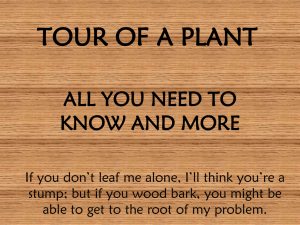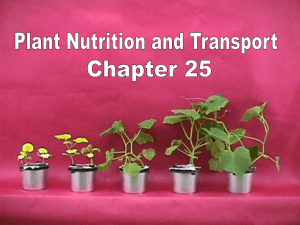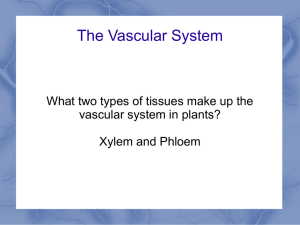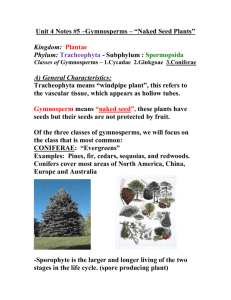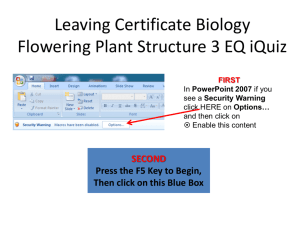PowerPoint format
advertisement
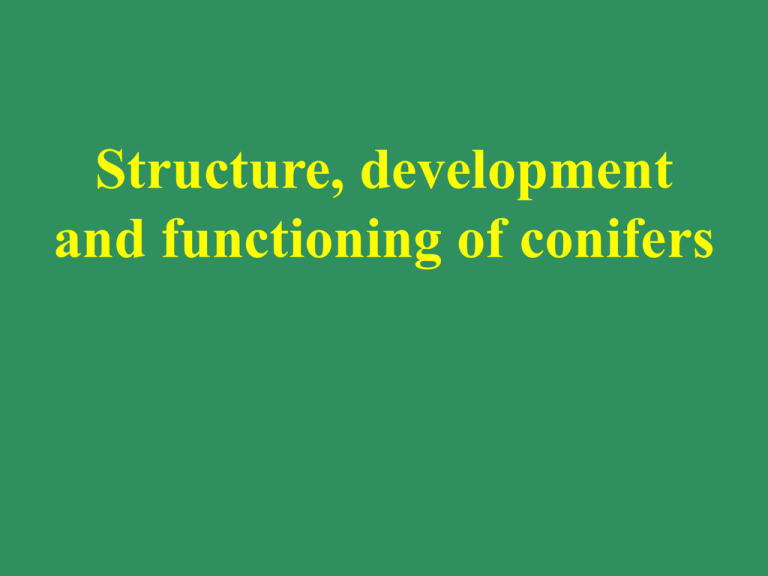
Structure, development and functioning of conifers Conifers as principal tree species in dry regions The Pinyon pine-Juniper community is an extreme, but widely distributed type in SW USA Zion Canyon Pinyon pine and Juniper Pinus monophyllum Pinyon pine with its crooked trunk and reddish bark, is found in dry, rocky places at elevations of 4,000-8,000 ft where yearly precipitation is only 10-20 inches. Tap roots stretch down 40 or more feet into the soil while lateral roots stretch as far. Very slow growth rates: a 6-10 foot diameter tree, 10 feet tall will be 80-100 years old. Juniperus osteosperma Utah juniper grows in dry, rocky or sandy locations in the high plateau country from 5000 to 9500 feet above sea level. It is the most common juniper of the Pinyon-juniper woodlands of the arid western intermountain basins. It is commonly 10 to 20 feet high with a maximum trunk diameter of 1 to 2 feet. Many conifers are xerophytes Xerophyte: a plant that can live where water supply is scanty or there is physiological drought Xerophytes have adaptations of leaves, stems and/or roots. Mesophyte: a plant that lives in places where the water supply is neither scanty nor abundant Two features of conifers: First, some basic nomenclature about patterns of plant growth and development Morphology and anatomy of needles Anatomy of wood Three basic tissue systems that running through the plant Three basic tissue systems that running through the plant This is based on angiosperms – but conifers do have the same basic organization! Fig. 31.6A Tissues A tissue is a cooperative unit of many similar cells that perform a specific function within a multicellular organism Tissues usually have cells that are specialized for particular functions For example the vascular tissue system conducts water and nutrients from roots to leaves through specialized cells for water conduction and conducts the products of photosynthesis, sugars, from leaves in different but equally specialized cells. Unfortunately… … biologists are rather lax in their use of the word “tissue”. Xylem Water from roots tissue Trachieds Parenchyma Conducting tissue Sugars from leaves Phloem tissue The Secondary Phloem in Pinus has Sieve and Albuminous Cells and Parenchyma with dark contents. But the principle holds true that a tissue is a group of specialized cells, frequently of different types, performing a specific function. … photosynthesis? Conifer needles (or fronds) The site of photosynthesis Exchange between the needle and the atmosphere of CO2 (into the needle) and water vapour (out of the needle). Why is water loss inevitable? Gaseous exchange takes place through a water film on the cells inside of the needle Stomata Stomata have central openings surrounded by two photosynthetic guard cells. Usually stomata are open during the day and closed at night but can close if the leaf dehydrates. Guard cells change the shape of the opening by changing their own shape. Epidermal cell Guard cell Thick inner wall Stoma Chloroplast In Taxus caespitosa and other conifers stomata are arranged in rows Cross-section through a pine needle The foliage of many but not all conifers also contains resin ducts. The lining cells secrete resin into the duct in response to leaf injury. Resin duct Cross-section through a pine needle Transfusion tissue Endodermis Phloem Xylem Guard cell Stoma Mesophyll Cuticle Epidermis Hypodermis The xylem and phloem are surrounded by undifferentiated cells called transfusion tissue. This is surrounded by an endodermis, which typically controls passage of materials between conducting tissue and ground tissue Conifer needles are generally thicker and tougher than many angiosperm leaves in part because they have a layer of thick- walled cells, the hypodermis, below the epidermis. They also tend to have a thick cuticle. Leaf cross section of Taxus (yew) The needle is broader than that of the pine, but still has only one vascular bundle The mesophyll is differentiated into palisade and spongy layers The endodermis is not so clearly developed as in the pine Leaf cross section of Podocarpus (a conifer) This needle is still broader, yet contains only one vascular bundle Center of needle Mesophyll is differentiated into palisade and spongy layers Endodermis How does wood form? What is it that we are seeing when we look at tree rings? Production of xylem and phloem tissues by the vascular cambium Secondary xylem is a complex tissue In conifers it consists of: tracheids that conduct water upwards, are long in the vertical direction, and have bordered pits parenchyma, thin walled cells ray cells running horizontally through the xylem and are composed mainly of parenchyma and some tracheids Cross secction of a young pine stem Direction of growth Cambium Ray initials Late wood Early wood Cambium and secondary xylem of a conifer Rays Tracheids with bordered pits Parenchyma Cambium and secondary xylem of a conifer Esau 1965 Production of secondary xylem and phloem by the vascular cambium Each time a cambial cell C divides one daughter cell retains its status as an initial and the other, the derivative D or D differentiates into a xylem X or phloem cell P Tracheids and rays, pine Radial longitudinal section http://www.uri.edu/artsci/bio/plant_anatomy/43.html Pits Tracheids with bordered pits, pine Tranverse longitudinal section Circular bordered pits of pine tracheids as seen in face view (left) and in side view (right). Bordered pits The torus at the center of the bordered pit moves and seals the pit when a tracheid aspirates http://www.uri.edu/artsci/bio/plant_anatomy/images.html Xylary resin duct in Pinus Ray Epithelial cell Tracheid Transverse section Sections you need to have read 7.2 31.5 31.6 Courses that deal with this topic ESC 221 Dendrology and Autecology
